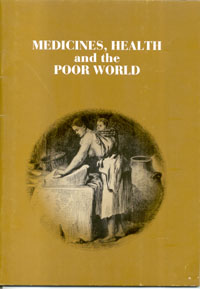In 1972 the Office of Health Economics produced a paper entitled Medical Care in Developing Countries. Drawing on both information available within the pharmaceutical industry and…
In 1972 the Office of Health Economics produced a paper entitled Medical Care in Developing Countries. Drawing on both information available within the pharmaceutical industry and the writings of commentators such as King (1966), Bryant (1969), Abel-Smith (1967) and Gish (1971), the report…
In 1972 the Office of Health Economics produced a paper entitled Medical Care in Developing Countries. Drawing on both information available within the pharmaceutical industry and the writings of commentators such as King (1966), Bryant (1969), Abel-Smith (1967) and Gish (1971), the report argued that medical resource allocation in most developing countries was too heavily biased towards urban, hospital based, curative medicine, OHE noted that in many poor countries two thirds to three quarters of public health spending goes on hospitals. This leaves very few resources available for the care of the 70 per cent or so of people who in a typical poor country live in the rural areas. Private health care is also likely by its very nature to benefit only a small minority of the population.
The 1972 paper stressed the potential value of improved primary health care facilities for the bulk of the less developed countries’ inhabitants. And it warned against excessive expenditure on sophisticated medical education in poor nations. The example of China was used to suggest that more reliance might usefully be placed on less expensively trained medical auxiliaries or community health workers. The study also maintained that Western aid in the form of prestigious, resource hungry medical equipment was often ill conceived, and argued instead that help aimed at meeting the essential requirements of the poor of Africa, Asia and Latin America should be the first priority. These include clean water supplies and adequate nutrition.
During the decade following the publication of Medical Care in Developing Countries several major international agencies took up new stances in relation to health care in the ‘poor world’. For instance, in 1975 the World Bank produced the first of its health sector policy papers. Table 1 outlines the Bank’s current understanding of the problems commonly encountered in this area. In 1976 McNamara, the then President of the World Bank, called for a global compact which would have the goal of meeting the basic needs of the world’s poorest people by the end of the twentieth century.
Despite the fears of some people in the third world that ‘basic needs’ policies might slow economic growth in poorer countries, or blind the international community to arguments in favour o f a redistribution of wealth between rich and poor nations, McNamara’s initiative was widely supported. In 1977 the World Health Organisation, which had, it has been suggested, previously lagged behind in this context (Mburu 1980), adopted the goal of ‘ health for all by the year 2000’.
In 1978 a joint WHO/United Nations Children Fund (UNICEF) conference held in Alma Ata in Kazakstan in the USSR strongly endorsed the view that the provision of low cost primary health care to the mass of the world’s people should be seen as an urgent international priority. The conference declaration argued that the latter was the vehicle by which all the people of the world might attain ‘a level of health that will enable them to lead a socially and economically productive life’.
Some aspects of the WHO’S ‘health for all’ (WHO 1979a) programme may be questioned (Passmore 1979). However, the political significance of the initiative is considerable (Bryant 1980). It has provided a much needed impetus to the drive for health development.
The year 1980 saw the publication of the Report of the Independent Commission on International Development Issues, better known as the Brandt Commission. This body was formed in the late 1970s at the suggestion of McNamara; its work served to highlight a number of matters relating to aid and the responsibility of the economically rich ‘North’ to assist the poor ‘South’. The Brandt prescription does not pay close attention to health care. But its proposals in areas like nutrition are highly relevant to the well-being of the 800 million or so individuals the World Bank describes as living in absolute poverty.
The work of the Commission has attracted some criticism (Raghavan 1981, Loraine 1981, Lancet 1981). And it may be thought not to have influenced the immediate course of world events to any great extent. Yet once again, it was an enterprise of considerable political significance.
This paper up-dates OHE’S previous work in the field of health in the developing countries taking into account the events of the last decade and extending the analysis provided to include an examination of the distribution and use of modern medicines in the ‘third world’. In the light of criticism made of industrial, professional and governmental behaviour it attempts to provide a balanced view of pharmaceutical use in the poor nations of Latin America, Africa and Asia, where three quarters of the world’s people consume only about one fifth of global drug production. It also examines aspects of medicine innovation, arguing that new pharmaceutical products may have significantly more to contribute to health care in the poor world than is generally perceived.
